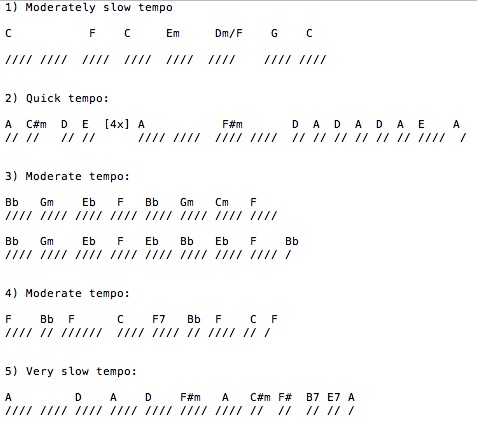Download “The Essential Secrets of Songwriting” 6-eBook Bundle, and get a 7th songwriting eBook FREE.
__________________
As you likely know, chord progressions are not protected by copyright, so you can feel free to take any progression you like and use it for your own purposes. Sometimes it can be fun to take the progression of a very well-known song, and create an entirely new melody above it, and wonder if anyone will ever recognize that progression. It may lead to one of those “I’m sure I’ve heard this before” moments for your listeners, which should drive them crazy, and provide you with a bit of a chuckle.
What follows are chord progressions from five very well-known folksongs. The number that follows each chord tells you how many beats the chord should be strummed if you want to use it exactly the way it was used in the song. Of course, that’s entirely up to you; it can be interesting to change up how the chords change (known as the harmonic rhythm) to suit your song.
I’ve put the names of each song that the progressions were borrowed from at the end of this post, in case you want to try guessing which songs they were taken from.
Because these chords were originally used for folksongs does not mean that you must use them that way. Most progressions are easily used in any style, genre or tempo. Use your imagination!
- Michael Row the Boat Ashore (as sung by The Highwaymen).
- If I Had a Hammer (as sung by Peter, Paul & Mary).
- Where Have All the Flowers Gone (as sung by Peter, Paul & Mary).
- Swing Low, Sweet Chariot (as sung by Johnny Cash).
- Shenandoah (as sung by Tennessee Ernie Ford).











Gary
Very interesting item on borrowing others’ chord progressions. I have always shied away from lifting them for fear of band ridicule about plagiarism. The only opportunities I got to use the sequences was during extemporisation (e.g. instrumental break) while playing the song itself. I will now think again. Thanks.
Incidentally, I got Kontakt a few months ago and amused myself during familiarisation by taking a classic and extemporising an instrumental break to its chords. In view of your comments, I got it out of archives and listened again with a view to formulating lyrics to my break. I concluded that my obvious borrowing would be spotted … you can listen to it at this link if you like (about 40s long). My version first, followed by the real tune. I am sure you will recognise it before the original starts at 25s.
Mystery tune: Click here (mp3)
Score (quantised): Click here .
Keep up the great posts – I always look forward to them.
Robert
Hi Robert,
It’s not what other musicians may hear in the chord sequence you have chosen, we must remember that the people who buy records in general do not hear chords, they hear words put to music, if you feel that your borrowed sequence is too close to the original (If it’s possible to pin down the original) it could be that your melody is too close to the song who’s
sequence you have borrowed. I often use that method as a start and then find myself replacing chords , I end up with a song un related to anything I’ve heard in the last forty years of listening to all genres known to man.
I think you are worrying unduly, the ones who may suggest your song is a copy of a previous hit, are usually so far off the mark that it’s quite laughable
Enjoy your writing Robert, dont worry about what others may think, the snobs are the ones
who have never written an original guitar lick, or a melody that is close to being memorable .
Pingback: FEATURED LINK: Chord Progressions of Well-Known Folksongs | Creative Music | Inspiring Musical Creativity
All good stuff, However those progressions need the odd Non Diatonic chord to make them come alive, in my opinion, Folk Music rarely used chords that were not diatonic to the home key. Of course we can use melody notes not normally found in the chosen key for the odd surprise, but like everything it’s knowing how much to use by trail and error
Hello:
I would add that instead of names of the chors I prefer to take into acount the number into the scale of that chord:
for example:
first song:
I IV I III II V I
second song:
I III IV V I VI IV I IV… V I
then I move around the capo to fix my (poor) voice, or I change the key… (i play guitar)
Finally I must recognise that it works for me just with the major scale (The only I now and work!!)
thanks very much!! I really enjoy this site!!
Thanks for writing. Yes, Roman numerals are great, especially for transposing to other keys. The reason I used chord names instead of numerals here is that many cannot quickly play a chord chart made up of Roman numerals until they’ve translated them into chord names. So I’ve sped the process up for them. If one of the progressions is of interest to a songwriter, it should be a quick process to create the Roman numerals.
Thanks again,
-Gary